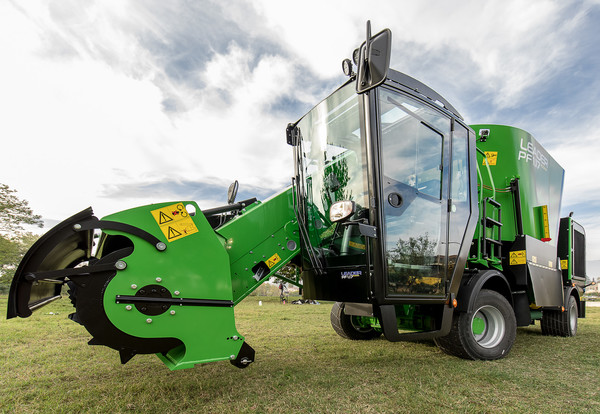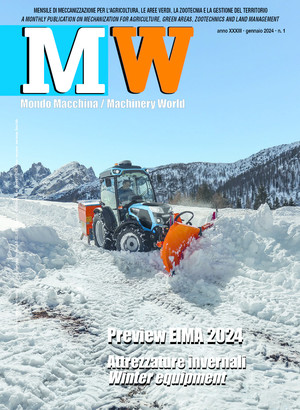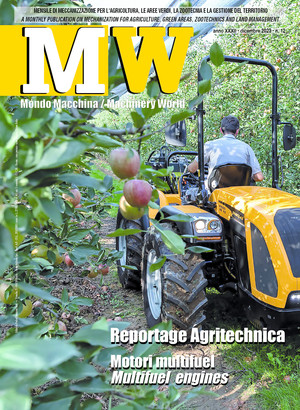
Vertical shredder-mixer wagons
Precision feeding plays an increasingly important role in livestock farms, effectively supporting farmers for the distribution of optimal and constant rations over time, thanks to the quality and quantity monitoring of each food, and subsequently the mixing and distribution of the ration in the feed lane
In animal nutrition, and especially in that of cattle, attention to well balanced and optimized rations is a very important factor under many points of view, primarily nutritional, economic and environmental. In the context of herd feeding, the mixing (shredder) wagons perform a fundamental task: for this reason, in recent times they have undergone considerable technological improvements. For a breeder, safety and reliability are essential, as well as obtaining optimal, palatable and uniform rations.
Without a doubt, the shredder-mixer wagons towed by the tractor are still very widespread, but greater agility and handling in the loading and unloading phases are definitely the highlights of self-propelled models, which among other things “free” a tractor that otherwise would be perpetually coupled to the application.
There are several manufacturers in this market sector, with machines able to offer a wide variety of choices, so as to be able to profitably be used in farms of any size. The most common models, however, are those with a hopper loading capacity between 10 and 30 m3, which combine excellent productivity with outstanding manoeuvrability. In addition, they are now all equipped with advanced engines, complying with the most restrictive limitations regarding exhaust emissions (Tier 4 final). These are engines that guarantee excellent performance and reduced fuel consumption, all to the benefit of environmental protection and economic expenditure.
In such a context, it is inevitable that electronics play a fundamental role; all manufacturers have designed solutions to autonomously adjust and manage the most delicate phases in the unifeed preparation. The main components being improved include the cutters for harvesting the forage in the trench and for loading the concentrates, in order to reduce unused residue and to respect the quality of the fibre, by varying the rotor rotation speed during the cut and with the offer of certain options for maximum efficiency.
Downstream, long and generously sized load channels, capable of transferring up to 10 m3 of product per minute, are increasingly being installed, to the benefit of the work routine’s speed. The hopper is equipped with augers for shredding the main ingredients equipped with wear-resistant steel blades, in order to ensure the material has a long product life.
Each manufacturer makes his own choices about the shapes of the augers and blades, but a constant is the presence of a large number of blades, combined with counter-blades that are adjustable hydraulically and whose movements are programmable electronically, thanks to a dedicated technology and a truncated conical shape of the mixing hoppers, capable of optimizing the mixing of the individual ingredients, also using natural gravity.
Sequence programming and electronic weighing of the incoming ingredients in real time are now a “must” on the latest versions of a shredder-mixer wagon. In addition, some models by Faresin Industries have an on-board display that alerts the operator to achieve the optimal mixing level before distribution in the feed lane and indicates the potential risk of selection of the food by the animals (which should hopefully be as low as possible). All this is based on the use of high-precision integrated sensors and a user-friendly communication of the result, which is immediately and easily understood by the operator in the cab.
When the mixture is ready, it is distributed in trenches through generally bilateral stainless steel discharge belts equipped with large doors. Permanent magnets are often found on the outlet, to intercept and block any ferrous impurities present which can damage the wagon, but above all, if swallowed, they cause serious health problems to the animals.
Being able to distribute homogeneous and balanced rations every day, respecting as much as possible the quality and the energetic and nutritional content of the diet, enables balancing the whole system, maintaining a productive and efficient herd over time, reducing food consumption and simultaneously increasing the livestock farm’s productivity.
Precision feeding
Since feeding livestock plays an increasingly important role in the farm’s economy (essentially due to the high production costs), being able to know exactly the nutritive composition of the diet can represent a considerable advantage. This step becomes relevant in a unifeed setup, in which the variability of the composition may turn out to be notably different from that established on paper by the farm nutritionists. Therefore, adopting tools to analyse incoming products becomes very valid, like the well-established NIR (Near InfraRed) technology, able to perform easy and accurate analyses in real time, so as to better adjust the composition of the ration according to the variability of the incoming ingredients, adapting the ration directly during the preparation phase. In practice, the dry matter content and the main nutrient parameters are measured for each component (e.g. fibre, protein, starch and ash), introducing into the diet the exact desired nutrient supply.
On traditional farms, the analysis of the ration is performed about once-twice a month, with the risk of persistent and consistent variations in diet compared to the optimal, with a negative impact on the animals’ nutrition. The sensors (and related electronics) to monitor the nutritional parameters can be mounted directly on the self-propelled mixer wagons, or more seldom on the fodder loading blades, especially in the case of towed models. Alternatively, specific portable instruments may be used.
In addition to an undeniable improvement in animal productivity, precision feeding brings additional benefits, such as less food waste and reduced purchases on the market, with the resulting environmental benefits. Continuous monitoring also enables better identification of individual critical issues of a farm, thus being able to intervene in a timely and targeted manner.
The accurate determination of the dry substance content of the individual ingredients, especially those rich in water such as silage and wet by-products (which more often than others are subject to changes in moisture content), makes it possible to adjust in real time the amount of food to be included in the ration. Among other things, the instrumentation in question is very versatile, with a possible use in many other production contexts.








